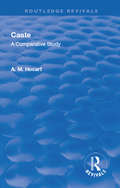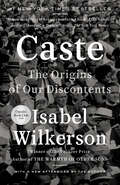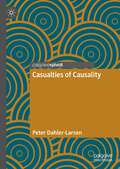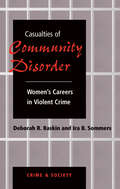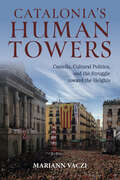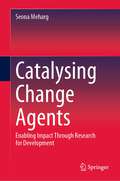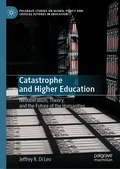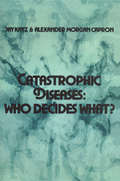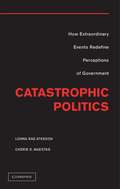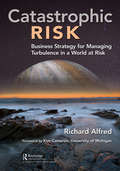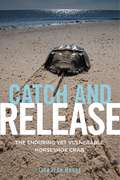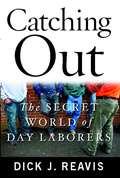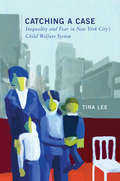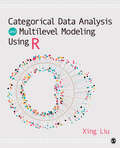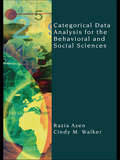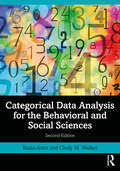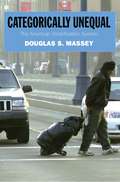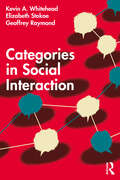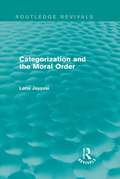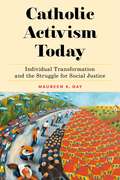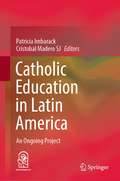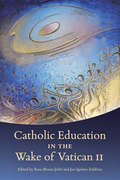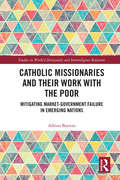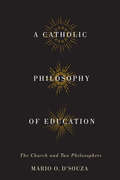- Table View
- List View
Caste: A Comparative Study (Routledge Revivals)
by Arthur Maurice HocartThe aim of this book is to persuade the reader that the Indian caste system is not the isolated phenomenon it is often thought to be. But a species of a very widespread genus. Not being an isolated phenomenon, it cannot be understood in isolation; it will merely be misunderstood. More than once it will be shown in these pages how localised specialism leads why from the truth and comparative study returns to it. Comparison also saves time by cutting the tangled knots which controversy ties round texts.
Caste: The Origins of Our Discontents
by Isabel WilkersonIn this brilliant book, Isabel Wilkerson gives us a masterful portrait of an unseen phenomenon in America as she explores, through an immersive, deeply researched narrative and stories about real people, how America today and throughout its history has been shaped by a hidden caste system, a rigid hierarchy of human rankings. <p><p> Beyond race, class, or other factors, there is a powerful caste system that influences people’s lives and behavior and the nation’s fate. Linking the caste systems of America, India, and Nazi Germany, Wilkerson explores eight pillars that underlie caste systems across civilizations, including divine will, bloodlines, stigma, and more. Using riveting stories about people—including Martin Luther King, Jr., baseball’s Satchel Paige, a single father and his toddler son, Wilkerson herself, and many others—she shows the ways that the insidious undertow of caste is experienced every day. She documents how the Nazis studied the racial systems in America to plan their out-cast of the Jews; she discusses why the cruel logic of caste requires that there be a bottom rung for those in the middle to measure themselves against; she writes about the surprising health costs of caste, in depression and life expectancy, and the effects of this hierarchy on our culture and politics. Finally, she points forward to ways America can move beyond the artificial and destructive separations of human divisions, toward hope in our common humanity. <p> Beautifully written, original, and revealing, Caste: The Origins of Our Discontents is an eye-opening story of people and history, and a reexamination of what lies under the surface of ordinary lives and of American life today. <P><P><b>A New York Times bestseller</b>
Casualties of Causality
by Peter Dahler-LarsenThis book offers a critique of the present status of the concept of causality in the social sciences. “The Causality Syndrome” consists of a belief in causal studies as more important than other studies, a narrow definition of causality, and rules of thumb regarding how to make causal claims. The book argues that the present dominance of this syndrome has considerable downsides and presents a challenge to social science. The book dissects the many interconnected ideas which undergird this syndrome and offers an intellectual home for advanced students, researchers and others who are concerned about the present dominance of The Causality Syndrome. The book critically discusses whether “causality” deserves the central position in social science that its advocates desire. The text shows how methodological rules about causal inference are used to protect causal studies from critique, even in situations where these rules are not followed. It is argued that institutionalization of these rules as symbols of good and trustworthy social science is highly problematic and comes with a price. One of the casualties of causality is that there is less motivation to study complex and pressing issues in society which do not lend themselves to causal study designs. The sections are short. The argument unfolds in a lively, engaged form with examples from many fields, including public health, evaluation and organizational studies. The case examples include classical experiments as well as contemporary research, e.g. studies of the effectiveness of restrictions targeting the spread of coronavirus.
Casualties of Community Disorder: Women's Careers in Violent Crime (Crime and Society)
by Deborah Baskin<p>Unlike the outcry over street crime committed by males, concerns about women and violence have centered primarily on their roles as victims of sexual and physical violence committed by strangers and by males in intimate relationships. Rarely is violence by women considered in the development or testing of theories of aggression. <p>The book provides a detailed account of the criminal careers of 170 women who committed violent street crimes in New York City, describing their entry into criminal activities, their development into persistent street criminals, and, for some, their eventual transition out of street crime.Unlike other qualitative works in this area, Casualties of Community Disorder offers more than cultural analysis. Deborah Baskin and Ira Sommers integrate structural and individual levels of explanation by examining the career patterns of female violent offenders and the relationships of these women to family members and communities. Through the use of census data, analyses of political and economic changes, and ethnographic observations of activities specific to these communities, the authors provide a perspective on the relationship of individual decisions to structural constraints. <p>The research presented here clearly challenges contemporary assumptions regarding female offending. Baskin and Sommers' analysis suggests a complex relationship of social and individual factors that serves as a caution against generic and gender-based generalizations that have been drawn from time-bound, aggregate level data sets and from ethnographies of women's involvement in street hustling. Finally, in Casualties of Community Disorder, the street drug and criminal subculture is understood through the words of those who usually are spoken for, studied, and objectified.</p>
Catalonia's Human Towers: Castells, Cultural Politics, and the Struggle toward the Heights
by Mariann VacziThe building of human towers (castells) is a centuries-old traditional sport where hundreds of men, women, and children gather in Catalan squares to create breathtaking edifices through a feat of collective athleticism. The result is a great spectacle of effort and overcoming, tension and release.Catalonia's Human Towers is an ethnographic look at the thriving castells practice—a symbol of Catalan cultural heritage and identity amid debates around national autonomy and secession from Spain. While the main function of building castells is to grow community through a low-cost, intergenerational, and inclusive leisure activity, Mariann Vaczi reveals how this unique sport also provides a social base, image, and vocabulary for the independence movement.Highlighting the intersection of folklore, performance, and sport, Catalonia's Human Towers captures the subtle processes by which the body becomes politicized and ideology becomes embodied, with all the desires, risks and precarities of collective constructions.
Catalysing Change Agents: Enabling Impact Through Research for Development
by Seona MehargThis book provides an overview of the challenges and opportunities for creating positive systemic change through research for development projects, providing four real-world examples. Practical insights are offered on identifying and cultivating change agents through your projects and programs, increasing the likelihood of enduring success. Understanding and participating in these types of interventions enable researchers and practitioners to become better agents of change themselves.
Catastrophe and Higher Education: Neoliberalism, Theory, and the Future of the Humanities (Palgrave Studies on Global Policy and Critical Futures in Education)
by Jeffrey R. Di LeoThis book asks what it means to live in a higher educational world continuously tempered by catastrophe. Many of the resources for response and resistance to catastrophe have long been identified by thinkers ranging from Ralph Waldo Emerson and William James to H. G. Wells and Emanuel Haldeman-Julius. Di Leo posits that hope and resistance are possible if we are willing to resist a form of pessimism that already appears to be drawing us into its arms. Catastrophe and Higher Education argues that the future of the humanities is tied to the fate of theory as a form of resistance to neoliberalism in higher education. It also offers that the fate of the academy may very well be in the hands of humanities scholars who are tasked with either rejecting theory and philosophy in times of catastrophe—or embracing it.
Catastrophic Diseases: Who Decides What?
by Jay Katz Alexander Morgan CapronAn important contribution in the burgeoning literature relating to the delivery of medical care, and to the broader question of responsible decision-making in those social areas where tragic choices have to be made. The effort is an excellent example of research into, and therapy for, an important social process.
Catastrophic Politics
by Lonna Rae Atkeson Cherie D. Maestas"Shocking moments in society create an extraordinary political environment that permits political and opinion changes that are unlikely during times of normal politics. Strong emotions felt by the public during catastrophes, even if experienced only vicariously through media coverage are a powerful motivator of public opinion and activism. This is particularly true when emotional reactions coincide with attributing blame to governmental agencies or officials. By examining public opinion during one extraordinary event, the aftermath of Hurricane Katrina, Lonna Rae Atkeson and Cherie D. Maestas show how media information interacts with emotion in shaping a wide range of political opinions about government and political leaders. Catastrophic events bring citizens together, provide common experiences and information, and create opinions that transcend traditional political boundaries. These moments encourage citizens to reexamine their understanding of government, its leaders, and its role in a society from a less partisan perspective"--
Catastrophic Risk: Business Strategy for Managing Turbulence in a World at Risk
by Richard L. AlfredImagine that you are a corporate executive or small business owner in a midwestern city under water after weeks of extreme weather and drenching rainfall. Infrastructure has been damaged beyond repair, transportation arteries are closed, and your supply chain is broken. Families have been driven from homes, food and water are in short supply, and people are becoming unruly. Government agencies are not in a position to help. Declining revenue and partisan antipathy fueled by ideological differences have eroded confidence in government. The city is in total disrepair and unable to deliver desperately needed services. It is edging toward implosion and community leaders have turned to you for help. Catastrophe that would have been unthinkable in earlier times is a reality in a world coming out of pandemic and facing existential threats such as climate change, inequality and global conflict. Catastrophic Risk: Business Strategy for Managing Turbulence in a World at Risk challenges business to step up and assume a pivotal role with communities under stress due to prolonged exposure to risk. When powerful societal forces meet behavior that deters response to risk, the consequences of risk are exacerbated. The compounding effect of behavior on risk has opened an important role for business in mobilizing people and communities in times of crisis. It is a role that cannot be fulfilled, however, without purpose, strategy and plans sufficiently robust to overcome the threat of risk. To prosper in this environment, business will need to make a significant contribution to society as well as to deliver financial performance. For companies, this will mean involvement in community in ways that significantly depart from current practice. For leaders, it will mean new skills—contextual sensitivity, a greater understanding of behavioral dynamics, and enhanced capacity to relate to people on an emotive basis. This book is about the relationship between risk, societal forces and human behavior—a relationship informed by the sciences that is critically important for business. Its goal is two-fold: to bring catastrophic risk to the world of business and to further business engagement in service to the common good.
Catch and Release: The Enduring Yet Vulnerable Horseshoe Crab
by Lisa Jean MooreThe unexpected and fascinating interspecies relationship between humans and horseshoe crabs.Horseshoe crabs are considered both a prehistoric and indicator species. They have not changed in tens of millions of years and provide useful data to scientists who monitor the health of the environment. From the pharmaceutical industry to paleontologists to the fishing industry, the horseshoe crab has made vast, but largely unknown, contributions to human life and our shared ecosystem. Catch and Release examines how these intersections steer the trajectory of both species’ lives, and futures. Based on interviews with conservationists, field biologists, ecologists, and paleontologists over three years of fieldwork on urban beaches, noted ethnographer Lisa Jean Moore shows how humans literally harvest the life out of the horseshoe crabs. We use them as markers for understanding geologic time, collect them for agricultural fertilizer, and eat them as delicacies, capture them as bait, then rescue them for conservation, and categorize them as endangered. The book details the biomedical bleeding of crabs; how they are caught, drained of 40% of their blood, and then released back into their habitat. The model of catch and release is essential. Horseshoe crabs cannot be bred in captivity and can only survive in their own ecosystems. Moore shows how horseshoe crabs are used as an exploitable resource, and are now considered a “vulnerable” species.An investigation of how humans approach animals that are essential for their survival, Catch and Release questions whether humans should have divine, moral, or ethical claims to any living being in their path.
Catching Out: The Secret World of Day Laborers
by Dick J. ReavisSeasoned journalist and professor Dick Reavis reported to a labor hall each morning, hoping to "catch out," or get job assignments. To supplement his retirement savings, the sixty-two-year-old North Carolinian joined people dispatched by an agency to manual jobs for which they were paid at the end of each day. Written with the flair of a gifted portraitist and storyteller, Catching Out describes Reavis's jobs at a factory; as a construction and demolition worker, landscaper, road crew flagman, auto-auction driver and warehouseman; and several days spent sorting artifacts in a dead packrat's apartment. On one pick-and-shovel job, he finds that his partner is too blind to see the hole they're digging. In each setting, he describes the personalities and problems of his desperate peers, the attitudes of their bosses, and the straits of immigrant coworkers, so many of whom make up the three-million-strong day-laborer poor. This is a gritty, hard-times evocation of the often colorful men and women on the bottom rung of the American workforce. It is partly a guide to performing hard, physical tasks, partly a celebration of strength, and partly a venting of ire at stingy and stern overseers. Reavis reminds us that physical exertion, even when painful or unpleasant, remains vital to the economy -- and that those who labor, though poorly paid, bring vigor, skill, and cunning to their tasks. In the tradition of Barbara Ehrenreich's Nickel and Dimed, Catching Out is destined to become a classic of our troubled times.
Catching a Case: Inequality and Fear in New York City's Child Welfare System
by Tina LeeInfluenced by news reports of young children brutalized by their parents, most of us see the role of child services as the prevention of severe physical abuse. But as Tina Lee shows in Catching a Case, most child welfare cases revolve around often ill-founded charges of neglect, and the parents swept into the system are generally struggling but loving, fighting to raise their children in the face of crushing poverty, violent crime, poor housing, lack of childcare, and failing schools. Lee explored the child welfare system in New York City, observing family courts, interviewing parents and following them through the system, asking caseworkers for descriptions of their work and their decision-making processes, and discussing cases with attorneys on all sides. What she discovered about the system is troubling. Lee reveals that, in the face of draconian budget cuts and a political climate that blames the poor for their own poverty, child welfare practices have become punitive, focused on removing children from their families and on parental compliance with rules. Rather than provide needed help for families, case workers often hold parents to standards almost impossible for working-class and poor parents to meet. For instance, parents can be accused of neglect for providing inadequate childcare or housing even when they cannot afford anything better. In many cases, child welfare exacerbates family problems and sometimes drives parents further into poverty while the family court system does little to protect their rights. Catching a Case is a much-needed wake-up call to improve the child welfare system, and to offer more comprehensive social services that will allow all children to thrive.
Categorical Data Analysis and Multilevel Modeling Using R
by Xing LiuCategorical Data Analysis and Multilevel Modeling Using R provides a practical guide to regression techniques for analyzing binary, ordinal, nominal, and count response variables using the R software. Author Xing Liu offers a unified framework for both single-level and multilevel modeling of categorical and count response variables with both frequentist and Bayesian approaches. Each chapter demonstrates how to conduct the analysis using R, how to interpret the models, and how to present the results for publication. A companion website for this book contains datasets and R commands used in the book for students, and solutions for the end-of-chapter exercises on the instructor site.
Categorical Data Analysis and Multilevel Modeling Using R
by Xing LiuCategorical Data Analysis and Multilevel Modeling Using R provides a practical guide to regression techniques for analyzing binary, ordinal, nominal, and count response variables using the R software. Author Xing Liu offers a unified framework for both single-level and multilevel modeling of categorical and count response variables with both frequentist and Bayesian approaches. Each chapter demonstrates how to conduct the analysis using R, how to interpret the models, and how to present the results for publication. A companion website for this book contains datasets and R commands used in the book for students, and solutions for the end-of-chapter exercises on the instructor site.
Categorical Data Analysis for the Behavioral and Social Sciences
by Razia Azen Cindy M. WalkerFeaturing a practical approach with numerous examples, this book focuses on helping the reader develop a conceptual, rather than technical, understanding of categorical methods, making it a much more accessible text than others on the market. The authors cover common categorical analyses and emphasize specific research questions that can be addressed by each analytic procedure so that readers are able to address the research questions they wish to answer. To achieve this goal, the authors: Review the theoretical implications and assumptions underlying each of the procedures Present each concept in general terms and illustrate each with a practical example Demonstrate the analyses using SPSS and SAS and show the interpretation of the results provided by these programs. A "Look Ahead" section at the beginning of each chapter provides an overview of the material covered so that the reader knows what to expect. This is followed by one or more research questions that can be addressed using the procedure(s) covered in the chapter. A theoretical presentation of the material is provided and illustrated using realistic examples from the behavioral and social sciences. To further enhance accessibility, the new procedures introduced in the book are explicitly related to analytic procedures covered in earlier statistics courses, such as ANOVA and linear regression. Throughout each chapter the authors use practical examples to demonstrate how to obtain and interpret statistical output in both SPSS and SAS. Their emphasis on the relationship between the initial research question, the use of the software to carry out the analysis, and the interpretation of the output as it relates to the initial research question, allows readers to easily apply the material to their own research. The data sets for executing chapter examples using SAS Version 9.1.3 and/or IBM SPSS Version 18 are available on a book specific web site. These data sets and syntax allow readers to quickly run the programs and obtain the appropriate output. The book also includes both conceptual and analytic end-of-chapter exercises to assist instructors and students in evaluating the understanding of the material covered in each chapter. This book covers the most commonly used categorical data analysis procedures. It is written for those without an extensive mathematical background, and is ideal for graduate courses in categorical data analysis or cross-classified data analysis taught in departments of psychology, human development & family studies, sociology, education, and business. Researchers in these disciplines interested in applying these procedures to their own research will appreciate this book’s accessible approach.
Categorical Data Analysis for the Behavioral and Social Sciences
by Razia Azen Cindy M. WalkerFeaturing a practical approach with numerous examples, the second edition of Categorical Data Analysis for the Behavioral and Social Sciences focuses on helping the reader develop a conceptual understanding of categorical methods, making it a much more accessible text than others on the market. The authors cover common categorical analysis methods and emphasize specific research questions that can be addressed by each analytic procedure, including how to obtain results using SPSS, SAS, and R, so that readers are able to address the research questions they wish to answer. Each chapter begins with a "Look Ahead" section to highlight key content. This is followed by an in-depth focus and explanation of the relationship between the initial research question, the use of software to perform the analyses, and how to interpret the output substantively. Included at the end of each chapter are a range of software examples and questions to test knowledge. New to the second edition: The addition of R syntax for all analyses and an update of SPSS and SAS syntax. The addition of a new chapter on GLMMs. Clarification of concepts and ideas that graduate students found confusing, including revised problems at the end of the chapters. Written for those without an extensive mathematical background, this book is ideal for a graduate course in categorical data analysis taught in departments of psychology, educational psychology, human development and family studies, sociology, public health, and business. Researchers in these disciplines interested in applying these procedures will also appreciate this book’s accessible approach.
Categorically Unequal: The American Stratification System
by Douglas S. MasseyThe United States holds the dubious distinction of having the most unequal income distribution of any advanced industrialized nation. While other developed countries face similar challenges from globalization and technological change, none rivals America's singularly poor record for equitably distributing the benefits and burdens of recent economic shifts. In Categorically Unequal, Douglas Massey weaves together history, political economy, and even neuropsychology to provide a comprehensive explanation of how America's culture and political system perpetuates inequalities between different segments of the population. Categorically Unequal is striking both for its theoretical originality and for the breadth of topics it covers. Massey argues that social inequalities arise from the universal human tendency to place others into social categories. In America, ethnic minorities, women, and the poor have consistently been the targets of stereotyping, and as a result, they have been exploited and discriminated against throughout the nation's history. African-Americans continue to face discrimination in markets for jobs, housing, and credit. Meanwhile, the militarization of the U. S. -Mexican border has discouraged Mexican migrants from leaving the United States, creating a pool of exploitable workers who lack the legal rights of citizens. Massey also shows that women's advances in the labor market have been concentrated among the affluent and well-educated, while low-skilled female workers have been relegated to occupations that offer few chances for earnings mobility. At the same time, as the wages of low-income men have fallen, more working-class women are remaining unmarried and raising children on their own. Even as minorities and women continue to face these obstacles, the progressive legacy of the New Deal has come under frontal assault. The government has passed anti-union legislation, made taxes more regressive, allowed the real value of the federal minimum wage to decline, and drastically cut social welfare spending. As a result, the income gap between the richest and poorest has dramatically widened since 1980. Massey attributes these anti-poor policies in part to the increasing segregation of neighborhoods by income, which has insulated the affluent from the social consequences of poverty, and to the disenfranchisement of the poor, as the population of immigrants, prisoners, and ex-felons swells. America's unrivaled disparities are not simply the inevitable result of globalization and technological change. As Massey shows, privileged groups have systematically exploited and excluded many of their fellow Americans. By delving into the root causes of inequality in America, Categorically Unequal provides a compelling argument for the creation of a more equitable society. A Volume in the Russell Sage Foundation's Centennial Series
Categories in Social Interaction
by Kevin A. Whitehead Elizabeth Stokoe Geoffrey RaymondThis book investigates the situated (re)production of categories, from the most mundane and unremarkable to those most strongly associated with power and privilege. By examining the reciprocal relationships between categorial phenomena and the basic structures and practices of social interaction, the book provides a new framework for integrating conversation analysis and membership categorization analysis.Across its ten chapters, the book describes a conversation analytic approach to studying categories and categorization, charts the development and history of membership categorization analysis, and addresses core methodological challenges and practices associated with using this approach. After mapping out the new framework developed in the book, each chapter describes intersections between categorial phenomena and the domains that comprise the infrastructure of social interaction. The book concludes by exploring applications, interventions, and impacts of understanding categories in ways examined across the preceding chapters, and by considering future avenues for excavating categorial practices in the ordinary, institutional, and technological settings of human social life.Categories in Social Interaction is essential reading for social scientists with an interest in categories of people and categorizing practices, and especially for practitioners and students of conversation analysis, membership categorization, ethnomethodology, and discursive psychology.
Categorization and the Moral Order (Routledge Revivals)
by Lena JayyusiFirst published in 1984, this is a study of categorization practices: how people categorize each other and their actions; how they describe, infer, and judge. The book presents a sociological analysis and description of practical activities and makes a cogent contribution to the study of how the moral order actually works in practical communicative contexts. Among the issues dealt with are: collectivity categorizations, the organization of lists and descriptions, moral attribution and inferences, and the relationship between standards of morality and standards of rationality.
Catholic Activism Today: Individual Transformation and the Struggle for Social Justice (Religion and Social Transformation #11)
by Maureen K. DayUncovers why Catholic organizations fail to foster civic activismThe American Catholic Church boasts a long history of teaching and activism on issues of social justice. In the face of declining religious and community involvement in the twenty-first century, many modern-day Catholic groups aspire to revive the faith as well as their connections to the larger world. Yet while thousands attend weekly meetings designed to instill religiosity and a commitment to civic engagement, these programs often fail to achieve their more large-scale goals.In Catholic Activism Today, Maureen K. Day sheds light on the impediments to successfully enacting social change. She argues that popular organizations such as JustFaith Ministries have embraced an approach to civic engagement that focuses on mobilizing Catholics as individuals rather than as collectives. There is reason to think this approach is effective—these organizations experience robust participation in their programs and garner reports of having had a transformative effect on their participants’ lives. Yet, Day shows that this approach encourages participants to make personal lifestyle changes rather than contend with structural social inequalities, thus failing to make real inroads in the pursuit of social justice. Moreover, the focus on the individual serves to undermine the institutional authority of the Catholic Church itself, shifting American Catholics’ perceptions of the Church from a hierarchy that controls the laity to one that simply influences it as they pursue their individual paths.Drawing on three years of interview, survey, and participant observation data, Catholic Activism Today offers a compelling new take on contemporary dynamics of Catholic civic engagement and its potential effect on the Church at large.
Catholic Education in Latin America: An Ongoing Project
by Patricia Imbarack Cristobal Madero SjThis book aims to be a reference for understanding an educational system throughout Latin America aligned with the Catholic Church. In both public and private sectors, whether it’s in the secular or the religious sector, considering Catholic Education brings up a question regarding the relevance of religion in the public sector, where education is presented as another alternative of education. This volume allows the reader to take a closer look into the recent challenges of Catholic Education in Latin America, such as quality and excellence, its anthropological dimension, as well as the ongoing dialogue between faith and culture. These essential elements are reflected upon, developing an educational process that responds to the current needs. Deep reflection is made in a contemporary and regional context throughout the eleven chapters of this book, all written by Latin American authors. Translation from the Spanish language edition: EDUCACIÓN CATÓLICA EN LATINOAMÉRICA. Un proyecto en marcha by Patricia Imbarack and Cristóbal Madero © Ediciones Universidad Católica de Chile, 2019. Original Publication ISBN 978-956-14-2459-3. All rights reserved
Catholic Education in the Wake of Vatican II
by Rosa Bruno-Jofre Jon Igelmo ZaldivarThe Second Vatican Council (Vatican II), called by Pope John XXIII in 1959, produced sixteen documents that outlined the Church’s attempts to meet increasing calls for modernization in the wake of social and cultural changes that were taking place in the twentieth century. Catholic Education in the Wake of Vatican II is the first work dedicated to the effects of the Second Vatican Council on catholic education in various national and cultural contexts. These original pieces, grounded in archival research, explore the social, political, and economic repercussions of Catholic educational changes in Canada, Europe, and South America. The volume provides insightful analysis of many issues including the tensions between Catholicism and Indigenous education in Canada, the secularization of curriculum in the Catholic classroom, Church-State relations and more. The contributors reveal the tensions between doctrinal faith and socio-economic structures of privilege found within the Church and introduces the reader to complex political interactions within the Church itself in the midst of a rapid era of secularization.
Catholic Missionaries and Their Work with the Poor: Mitigating Market-Government Failure in Emerging Nations (Studies in World Christianity and Interreligious Relations)
by Albino BarreraThis book explores the vital role of faith-based organizations (FBOs) in compensating for the market’s and government’s inability to provide vital services. Its key theoretical contribution is the notion that poverty is the result of a triadic failure—when markets, government, and civil society become dysfunctional at the same time. Using data on Catholic missionaries’ development work, this study presents the various ways by which FBOs mitigate market and government failures in healthcare, education, and social services, and in the process build and strengthen civil society. This study has two main objectives. First, it aims to present an overview of missionaries’ development work, evaluating the socioeconomic significance of their faith-based development work. In addition, various comparative advantages and disadvantages have been imputed to FBOs in the religion-development literature, and we assess to what extent missionaries actually exhibit these posited qualities in practice. Second, the groundwork is laid for future religion-development scholars by presenting a theoretical framework and a method for evaluating the role and contributions of FBOs in the larger community. This is an important investigation of contemporary worldwide Christianity and its relationship with development. As such, it will interest scholars of religious studies and missiology, as well as development economics, public service and the political economy.
Catholic Philosophy of Education: The Church and Two Philosophers
by Mario O. D'SouzaToday’s pluralist and multicultural society raises questions about how to teach religiously and ethnically diverse students in Catholic schools. A Catholic Philosophy of Education addresses these challenges by examining the documents from the Roman Congregation for Catholic Education alongside the writings of Jacques Maritain and Bernard Lonergan. Mario D’Souza proposes a contemporary formulation for a Catholic philosophy of education in which the ideals of Catholicism form the basis for the mission of the Catholic school. Drawing on the Church’s educational documents, and informed by Maritain and Lonergan, D’Souza explains how the unifying anthropology of Catholic education enables Catholic schools to serve amidst diversity by avoiding the extremes of religious exclusivism and fundamentalism, on the one hand, and relativism and individualism, on the other. He explores the aims of Catholic schools in relation to students, teachers, and society, and the relationship between goodness, discipline, and knowledge. He argues that students must be educated for personal and communal freedom and authenticity, and to strive for the common good, suggesting how a Catholic philosophy of education can provide the framework for such personal and communal transformation. Essential reading for new and experienced Catholic educators, A Catholic Philosophy of Education demonstrates that Maritain and Lonergan have much to offer in service of an education that is liberating, instructive, illuminating, and integrative.
